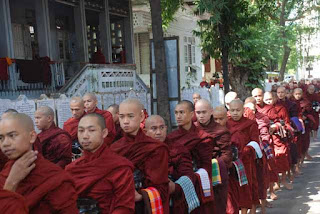 Travel from Bagan to
Travel from Bagan to Mingun Pagoda, unfinished as it was abandoned on the death of king Budawpaya in 1819, would when finished apparently have been the largest in the world rising to 500 feet, three times its present size. The base was only completed by thousands of slaves and prisoners of war. It has subsequently suffered earthquake damage but the climb gave some great Ayeyarwady views.Our guide gave us tree branches to walk on as the ground was so hot. It is a mark of respect to even remove footwear before entering all religious sites in Myanmar so the feet could become quite tender.
Mingun also claims another "world's largest" - a bronze bell weighing about 90 tons. This King Bodawpaya planned to go with his stupa. While it is about one third the size of the world's largest bell in Moscow, it is the largest uncracked bell in the world. For pictures click here - our photos were not suitable.
Back in Mandalay for lunch we were guided in the mystique of Burmese cuisine, rice, curry side dishes of sauces and vegetables. Mostly too spicy and sour for our tastes. We are not lovers of loads peanut oil and mountains of shrimp paste but we always find a part to eat, occassionly only the rice.
Back in Mandalay for lunch we were guided in the mystique of Burmese cuisine, rice, curry side dishes of sauces and vegetables. Mostly too spicy and sour for our tastes. We are not lovers of loads peanut oil and mountains of shrimp paste but we always find a part to eat, occassionly only the rice.
It was to be a golden afternoon. At the Mahamuni Paya, also originally built by King Budawpaya, there is a bronze Buddha statue that has, over the years, been so covered by gold leaf applied by devotees that its shape is totally unrecognisable. Only the head is not so covered and is washed every morning by monks.
 In keeping with custom only men are permitted to approach it and apply the gold leaf. At the same temple there are several bronze images of mainly Hindu dieties, originally looted from Angkor Wat (Cambodia) but successively looted from other resting places before ending up here.
In keeping with custom only men are permitted to approach it and apply the gold leaf. At the same temple there are several bronze images of mainly Hindu dieties, originally looted from Angkor Wat (Cambodia) but successively looted from other resting places before ending up here. There are streets of crafts in Mandalay include marble working. We admired and opted out of close inspection because of the dust.
The Royal Palace was destroyed during WWII but the main part was rebuilt not particularly well, and apparently using forced labour, in the 1990s for the forthcoming tourist boom of 1996. About the only thing the reconstruction does is give an idea of the scale of the original. The reconstruction itself seems rather a pointless use of resources. The scale is also obvious from the moat and walls. The road trip around the outside its 12 km. Fortunately the "Lion Throne" which was in the palace had been removed to India by the British. and on independence was returned to the national Museum in Yangon.
Another claimed world's record was the "worlds largest book" - The entire Tripitaka are inscribed on 729 marble slabs,. Each in its own stupa in the Kuthodaw Paya. In 1900 a paper edition of the stoneorigional was printedin 38 volumes, each with 400 pages.
It is obligatory to take in the view from Mandalay Hill at sunset which would have been good, if it hadn't been for the smoke haze!
It is expected that a boy will join a monestary for a month at about ten years old and again for a shorter while in his late teens. The parents see this as an honour and a time of great celebration.
In Amapura, briefly the capital before it moved to Mandaley, we visited a monastery housing 1,000 monks. . Rather than all 1000 descending on the local population with their alms bowls each morning the donors for that day come to the monastery and the monks form a queue, collect their food and other donations - toothpaste, soap etc - before eating in the refectory.
After a ferry trip across a tributary of the Ayeyarwady a horse-drawn cart along some pretty rough tracks took us to Ava and Bagaya Kyaung, a old teak wood monastery, where monks were teaching young children in the cool dark interior.
In leafy green Sagaing where even more monasteries abound we visited a nunnery where it was apparent that Buddhist nuns are expected to do much more for themselves than are monks - they were busy preparing breakfast for the next day and are not constrained by the same amount of rules.
The Mustache brothers cabaret show is a Mandalay attraction - at least for foreign visitors. We decided to walk the few blocks to it as taxi drivers were reluctant to take us. Half way a tuk tuk picked us up and promised to bring us back. You have the feeling that the locals know of the preformance in a front room at a certain time of day. There are three brothers, of whom one speaks good English, together with their wives and sisters. The show has an expected dated flavour comprises satire, song and dance and is based on traditional folk opera.
 |
| Myanmar style football |





















